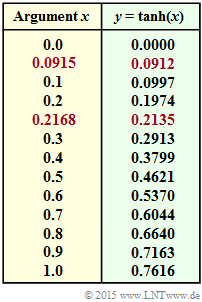Exercise 4.5Z: Tangent Hyperbolic and Inverse
In the "Theory Part" it was shown, using the example of a "single parity–check code" that the extrinsic $L$ value with respect to the $i^{th}$ symbol is defined as follows:
- $$L_{\rm E}(i) = {\rm ln} \hspace{0.2cm}\frac{{\rm Pr} \left [w_{\rm H}(\underline{x}^{(-i)})\hspace{0.15cm}{\rm is \hspace{0.15cm} even} \hspace{0.05cm} | \hspace{0.05cm}\underline{y} \hspace{0.05cm}\right ]}{{\rm Pr} \left [w_{\rm H}(\underline{x}^{(-i)})\hspace{0.15cm}{\rm is \hspace{0.15cm} odd} \hspace{0.05cm} | \hspace{0.05cm}\underline{y} \hspace{0.05cm}\right ]} \hspace{0.05cm}.$$
- This equation is also applicable to many other channel codes.
- The code word $\underline{x}^{(-i)}$ in this definition includes all symbols except $x_i$ and has thus only length $n-1$.
In the $\text{Exercise 4.4}$ it was shown that the extrinsic $L$ value can also be written as follows:
- $$L_{\rm E}(i) = {\rm ln} \hspace{0.2cm} \frac{1 + \pi}{1 - \pi}\hspace{0.05cm}, \hspace{0.3cm} {\rm with} \hspace{0.3cm} \pi = \prod\limits_{j \ne i}^{n} \hspace{0.15cm}{\rm tanh}(L_j/2) \hspace{0.05cm}.$$
In this exercise, we will now look for another calculation possibility.
Hints:
- This exercise belongs to the chapter "Soft–in Soft–out Decoder".
- Reference is made in particular to the "Calculations of extrinsic log likelihood ratios" section.
- Above you can see a table with the numerical values of the function $y = \tanh(x)$ ⇒ "hyperbolic tangent".
- With the rows highlighted in red you can read the values of the inverse function $x = \tanh^{-1}(y)$ needed for subtask (5).
Questions
Solution
- $$L_{\rm E}(i) = {\rm ln} \hspace{0.2cm} \frac{1 + \pi}{1 - \pi}\hspace{0.05cm}, \hspace{0.3cm} {\rm with} \hspace{0.3cm} \pi = \prod\limits_{j \ne i}^{3} \hspace{0.15cm}{\rm tanh}(L_j/2) \hspace{0.05cm}.$$
- From the table on the specification section can be read:
- $$\tanh {(L_1/2)} = \tanh {(0.5)} = 0.4621,$$
- $$\tanh {(L_2/2)} = \tanh {(0.2)} = 0.1974.$$
- Since the hyperbolic tangent is an odd function, the following applies further
- $$\tanh {(L_3/2)} = -\tanh {(0.5)} = -0.4621.$$
- Calculation of $L_{\rm E}(1)$:
- $$\pi = {\rm tanh}(L_2/2) \cdot {\rm tanh}(L_3/2) = (+0.1974) \cdot (-0.4621) = - 0.0912\hspace{0.3cm} \Rightarrow \hspace{0.3cm} L_{\rm E}(1) = {\rm ln} \hspace{0.2cm} \frac{1 -0.0912}{1 +0.0912}\hspace{0.15cm}\underline{=-0.1829} \hspace{0.05cm}.$$
- Calculation of $L_{\rm E}(2)$:
- $$\pi = {\rm tanh}(L_1/2) \cdot {\rm tanh}(L_3/2) = (+0.4621) \cdot (-0.4621) = - 0.2135\hspace{0.3cm} \Rightarrow \hspace{0.3cm} L_{\rm E}(2) = {\rm ln} \hspace{0.2cm} \frac{1 -0.2135}{1 +0.2135}\hspace{0.15cm}\underline{=-0.4337} \hspace{0.05cm}.$$
- Calculation of $L_{\rm E}(3)$:
- $$\pi = {\rm tanh}(L_1/2) \cdot {\rm tanh}(L_2/2) = (+0.4621) \cdot (+0.1974) = + 0.0912\hspace{0.3cm} \Rightarrow \hspace{0.3cm} L_{\rm E}(3) = {\rm ln} \hspace{0.2cm} \frac{1 +0.0912}{1 -0.0912}\hspace{0.15cm}\underline{=+0.1829}= - L_{\rm E}(1) \hspace{0.05cm}.$$
(2) Correct are the solutions 1, 2, 3, and 5: The function
- $$y ={\rm tanh}(x) = \frac{{\rm e}^{x}-{\rm e}^{-x}}{{\rm e}^{x}+{\rm e}^{-x}} = \frac{1-{\rm e}^{-2x}}{1+{\rm e}^{-2x}}$$
is computable for all $x$ values and $\tanh(-x) = -\tanh(x)$ holds.
- For large values of $x$: ${\rm e}^{-2x}$ becomes very small, so that in the limiting case $x → ∞$ the limit $y = 1$ is obtained.
(3) Since the "hyperbolic tangent" only yields values between $±1$, the inverse function $x = \tanh^{-1}(y)$ can also only be evaluated for $|y| ≤ 1$.
- By rearranging the given equation
- $$x ={\rm tanh}^{-1}(y) = 1/2 \cdot {\rm ln} \hspace{0.2cm} \frac{1+y}{1-y}$$
- one obtains:
- $${\rm e}^{2x} = \frac{1+y}{1-y} \hspace{0.3cm}\Rightarrow \hspace{0.3cm} {\rm e}^{-2x} = \frac{1-y}{1+y} \hspace{0.3cm}\Rightarrow \hspace{0.3cm} (1+y) \cdot {\rm e}^{-2x} = 1-y \hspace{0.3cm} \Rightarrow \hspace{0.3cm}y = \frac{1-{\rm e}^{-2x}}{1+{\rm e}^{-2x}} = {\rm tanh}(x) \hspace{0.05cm}.$$
- This means:
- The equation given in the proposed solution 2 is correct.
- In the limiting case $y → 1$, $x = \tanh^{-1}(y) → ∞$ holds.
- Also the inverse function is odd ⇒ in the limiting case $y → -1$ goes $x → -∞$.
- Accordingly, the proposed solutions 2 and 4 are correct.
(4) Starting from the equation.
- $$L_{\rm E}(i) = {\rm ln} \hspace{0.2cm} \frac{1 + \pi}{1 - \pi}$$
one arrives with the result of (3) at the equivalent equation corresponding to proposed solution 2:
- $$L_{\rm E}(i) = 2 \cdot {\rm tanh}^{-1}(\pi)\hspace{0.05cm}.$$
(5) With the result of the subtask (1) we get
- for the first extrinsic $L$ value, since $\pi_1 = -0.0912$:
- $$L_{\rm E}(1) = 2 \cdot {\rm tanh}^{-1}(-0.0912)= -2 \cdot {\rm tanh}^{-1}(0.0912) = -2 \cdot 0.0915\hspace{0.15cm}\underline{=-0.1830} \hspace{0.05cm}.$$
- for the second extrinsic $L$ value, since $\pi_2 = -0.2135$:
- $$L_{\rm E}(2) = -2 \cdot {\rm tanh}^{-1}(0.2135) = -2 \cdot 0.2168\hspace{0.15cm}\underline{=-0.4336} \hspace{0.05cm}.$$
- for the third extrinsic $L$ value, since $\pi_3 = +0.0912 = -\pi_1$:
- $$L_{\rm E}(3) = -L_{\rm E}(1) \hspace{0.15cm}\underline{=+0.1830} \hspace{0.05cm}.$$
Note:
- The result was determined using the red table entries on the information section.
- Except for rounding errors $($multiplication/division by $2)$, the result agrees with the results of subtask (1).
